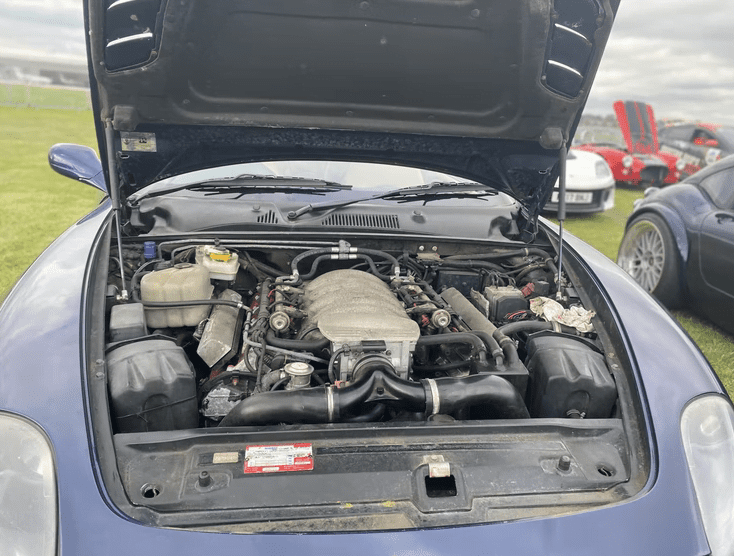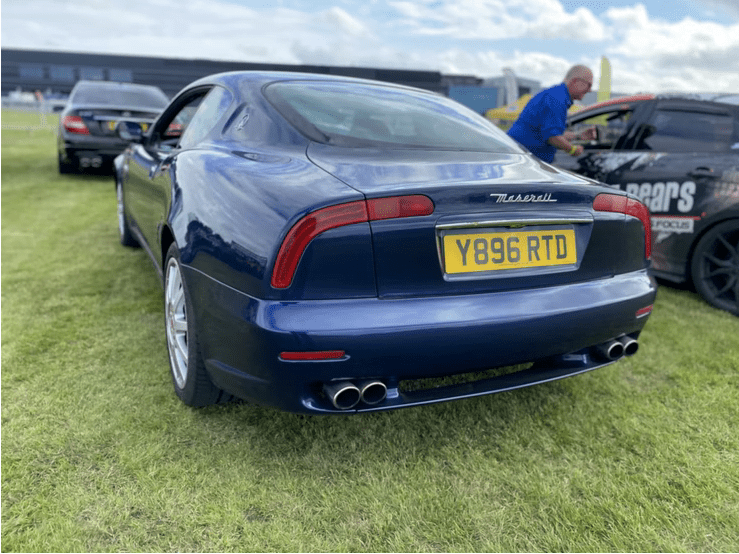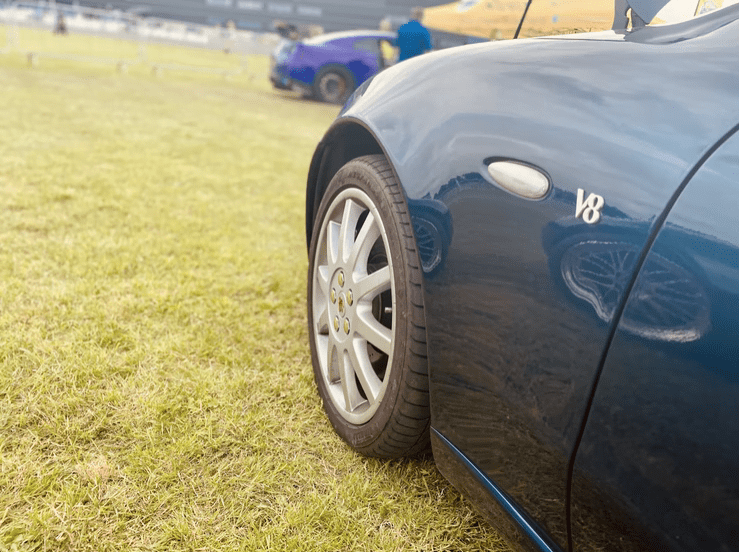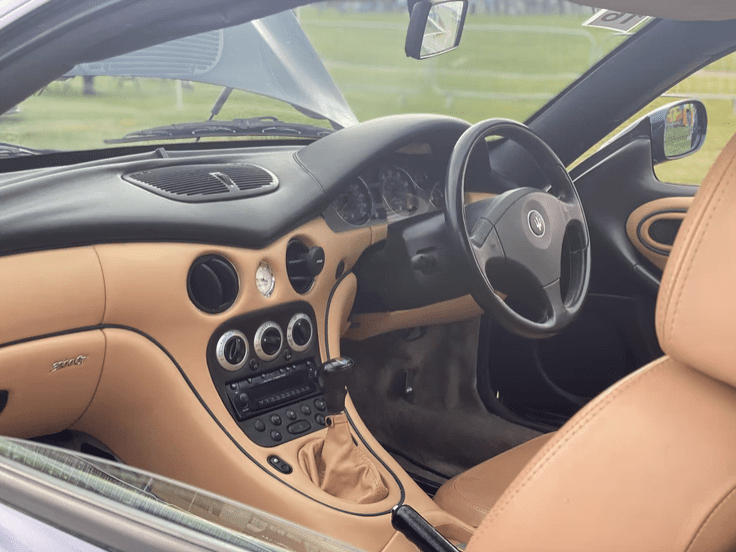Want a Ferrari but only have £10,000?
When I think of things that are great value for money, I think of two things: a £3 meal-deal, and one particular car from the Ferrari-era of Maserati. It’s called the 3200 GT and I truly believe it to be the best thing you can buy for £10,000 – and one of the best value cars today.
I say this after attending one of Sporting Bears’ events, at which the charitable organisation had many vehicles for people to go out for passenger rides in – more on Sporting Bears later on.
Engine
The highlight of the 3200 GT, for me, is it’s marvellous engine. It’s a 3.2-litre twin-turbocharged V8 which produces 370 horsepower, and 442 Nm of torque. This gives the 3200 GT what it needs in order to do 0-60 mph in 5.1 seconds, and hit a top speed of 174 mph. The automatic version is a bit slower however – it does 0-60 mph in 5.7 seconds, and maxes out at 168 mph.
Dubbed the AM578, it’s an engine which can be traced back to 1981 when it was first used as a 2.8-litre V6 in the Maserati Biturbo. Nine years on, and it was first seen in V8 form when Maserati released the Shamal in 1990. The engine now had a displacement of 3.2 litres, and produced an impressive 330 horsepower.
Ferrari then assumed control of Maserati in July 1997. One of their main missions was to improve the quality of the vehicles, as Maseratis were renowned for their unreliability. The Quattroporte Evoluzione was then released in 1998. It appeared to be the almost identical as the previous version, however every aspect of the car had been revisited in order to ensure that it was more reliable – but Ferrari wanted a more dramatic way to announce its new control of Maserati.
And so came the 3200 GT. It utilised the same engine as the Quattroporte Evoluzione, except it produced 370 horsepower compared to the Quattroporte’s 335 hp.
This engine proved to be so good that Maserati, Ferrari and Alfa Romeo continued to use it long after the 3200 GT. In 4.2-litre form, the engine was used in the Maserati Coupe – which was the successor to the 3200 GT.
Ferrari then decided to use the engine, this time in 4.3-lite form, in two of their own cars: the 430 Scuderia and the California. Finally, the engine was used in the Maserati GranTourismo and Alfa Romeo 8c as a 4.7-litre V8.
You’ll notice that the Ferraris sound very different to the Maseratis, despite them having almost identical engines. This is because Ferrari favoured flat-plane cranks, whereas Maserati favoured cross-plane cranks. I personally prefer the Maserati engine, mainly due to its raw and dirty sound – take a listen:
The power from the 3200 GT’s engine is fed through one of two different transmissions: a six-speed manual, or a 4-speed automatic. The latter was released shortly after the manual version and was called the 3200 GT Automatica – or 3200 GTA for short. Something which all versions of the 3200 GTs share in common is the fact that 100% of their power is sent to the rear wheels.
As I‘ll explain later on, it’s how the engine delivers its power which makes it so impressive – but how does the car look once you close the bonnet?
Exterior
All this performance is packed into what is a rather unassuming body. It’s not low and wide like a Ferrari, and it doesn’t have ridiculous vents or 12 exhausts at the back like a Lamborghini. Instead, the car sits close to the ground – but not so low whereby getting in and becomes a form of exercise. The 3200 GT’s narrower bodystyle also helps to fool you into thinking that it’s a small car, when in reality it’s actually bigger than the 911 of its time.
Focus your attention to the back of the car and you’ll notice an incredibly unique pair of brake lights. Dubbed the ‘boomerang’ design, these are the first ever LED brake lights to have been fitted to a car – and they look absolutely stunning. They contour to the overall shape of the car, accentuating its lines to make for a more athletic profile.
Unfortunately, these lights didn’t live for too long as the 3200 GT’s successor, the Maserati Coupe, has normal brake lights. Rumour has it that the LED lights did not comply with the USA’s regulations, hence they disappeared in 2002. Further down from these boomerang headlights are four beautiful stainless steel exhaust pipes, from which the glorious tune of the 3.2-litre V8 exits.
The side of the 3200 GT is a slight disappointment In my opinion. I think that Maserati could have done a lot more to make this portion of the car stand out, instead of making it as plain as it is. Fortunately, there are some unique design quirks which partially make up for this.
For instance, the fuel filler cap is in a rather odd position as it sits incredibly high up. The reason for this is because the 3200 GT‘s fuel tank sits in between the rear passenger seats, and the boot. Next to the fuel filler cap, is a Maserati badge – which is probably a way to make you feel better on the many occasions you’ll be refuelling the car at a petrol station.
Modern cars often have something which dominates the front of the car. The new BMW M4 for instance borrows SpongeBob’s front teeth, and uses them for a front grille. The front of the Maserati however isn’t really dominated by anything – instead, all it’s features come together in perfect harmony to form the perfect nose.
The vented bonnet for example shows the car’s immense performance, but its refined front grille and pretty headlights remind you of its comfort and touring abilitiesis in fact a GT car – it’s just perfect.
With all that being said, I do wish that the 3200 GT looked a bit more flamboyant overall. Even though it‘s supposed to be a GT, at the end of the day, it’s still a Maserati. Especially when you consider how Ferrari was in control of the company at the time, I think the designers could have been a bit more frivolous and fun with the design, whilst still maintaining a suitable level of sophistication for it to still be considered a GT.
Interior
When inside the car, you feel like you’re in your own leather cocoon. This example has a two-tone leather interior with contrast piping which – especially with the blue exterior paint – works perfectly. It’s the perfect combination of Italian style, and traditional comfort.
As mentioned, the exterior of the car is slightly deceiving as it makes the 3200 GT look smaller than it actually is. In reality, it’s larger than the Porsche 996 – a car which also has four seats. The issue with the Porsche however is that you can’t actually fit a normal human being in the back, meaning you can really only ever have two people in the car. By contrast, the Maserati boasts enough interior space to make its rear seats usable – meaning three of your friends can experience the thrill of the 3200 GT on the road with you.
Focus on the door cards and you’ll notice how there are no window controls. This is because they are located on the centre console, which meant that Maserati didn’t have to change the door cards depending on the side of the steering wheel.
The centre console also has a button to switch off the car’s parking sensors – which I find rather funny as you still get the button even if the car doesn’t actually have parking sensors as a fitted option. Further above this button is the classic Maserati interior clock, a distinctive feature of any Maserati‘s cabin.
If you want to open the boot or fuel cap, you’ll need to open the glovebox as both release switches are located here – which is a bit odd. Close the glovebox, and you’ll see the 3200 GT badge on the glovebox – which, unfortunately, is one of the only obvious ways to tell what you are sat in.
The Maserati 3200 GT is a special car, it differs from the crowd – which is why you buy it. The engine, and body reflect this in near perfect fashion; but, as beautiful as it is, the interior isn’t really unique – which is a bit of a shame in my opinion.
On the road
Thought it does look fantastic, on the road is where you get your money’s worth.
The version I went out in was the Automatica. This means that all that power from the engine then gets sent to the rear wheels via a 4-speed automatic gearbox – which might not sound too appealing. Obviously, the fact that it’s rear-wheel drive sounds good – but a 4-speed automatic transmission is quite the opposite. However, as soon as we took off, my opinion immediately changed.
To go forward, you just put your foot down and feel yourself getting more and more compressed into your seat. You don’t need to worry about changing gear, you just keep your foot down. Acceleration feels absolutely relentless, courtesy of the 3200 GTA’s long gears – it almost feels dangerous as you reach a higher RPM.
The sport button sharpens throttle response, and allows the car to rev right up until 7000 RPM. It also stiffens the suspension, which is futile in my opinion.
Even in the car’s normal driving mode, the ride isn’t exactly buttery smooth, despite it being a GT car. The suspension setup makes the 3200 GT feel more like a sports car instead of the GT Maserati claims it to be.
The version of the 3200 GT I got to experience was the 3200 GT Automatica, or the GTA for short. There is a six-speed manual version available however it fails to properly cope with the engine of the car.
The sport button allows the car to rev right up until 7000 RPM in the auto, doesn’t do much in the manual. Also sharpens throttle response, and stiffens the suspension – but even in normal mode, it’s not exactly buttery smooth; despite being a GT car – more like a sports car.
The steering is also not very GT-like, mainly due to how responsive it is. Maserati was criticised so much for this that they actually altered the steering of the 3200 GT in 2001, to make it slightly less twitchy. Personally, I don’t see it as a particularly big issue because – despite what Maserati claims – the 3200 GT is a sports car at heart, it’s just covered in some fancy leather to make it more GT-like.
The manual version of the 3200 GT might seem like the better option, but I think otherwise. The best thing about the 3200 GT isn’t just the engine, but it’s how the engine delivers power in such a smooth manner. The gearbox in the Automatica is tailored to work with the engine, whereas the manual transmission isn’t – which is why it almost struggles to cope with the power.
Final thoughts
This is one of my last ever reviews which will be published here on DriveTribe. I’ve been on this platform for the better part of two years, and this is one of the closing chapters to my time on this platform. This might seem like a rather random thing to mention but over the past few days, I’ve been thinking a lot about all the cars I’ve seen and experienced during my two years.
All the cars that initially come to mind are big, loud, flashy supercars with price tags to match – and then there’s the Maserati.
It’s not a car reserved exclusively for the billionaires of this world, and it’s not a car which will try to kill you if you take it down to your local supermarket. The Maserati 3200 GT is a car which a lot of people can actually use, and – more importantly – one which is far more attainable than you would think.
With some examples being listed for as low as £10,000, the 3200 GT costs less than a new Ford Fiesta – and the Fiesta doesn’t come with a twin-turbocharged V8 engine. But, the 3200 GT isn’t just a car with a nice-sounding engine. It’s comfortable, rare, and beautiful to look at.
Granted, it will cost you a bomb to refill and parts for the car aren’t exactly easy to find; but for £10,000, it will put one big smile on your face.
Sporting Bears
If you like the sound of this Maserati 3200 GT, you can experience it with Sporting Bears at one of their events. And if it’s not to your liking, you can go out for a passenger ride in another one of their 2000 cars across the UK.
At The British Motor Show last year, Sporting Bears established a strong presence by attracting an incredibly large crowd with their impressive fleet of cars. They also raised an incredible grand total of £41,029.80 for charity at this event.






